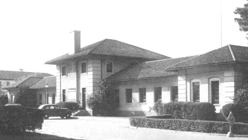Potential Exposure at Fort McClellan

Photo: U.S. Army
Fort McClellan was an Army installation in Alabama that opened in 1917 and closed in 1999 as part of the Army Base Closure and Realignment Committee (BRAC) program.
Some members of the U.S. Army Chemical Corp School, Army Combat Development Command Chemical/Biological/Radiological Agency, Army Military Police School, and Women's Army Corps, among others, may have been exposed to one or more of several hazardous materials, likely at low levels, during their service at Fort McClellan.
Potential exposures could have included, but are not limited to, the following:
- Radioactive compounds (cesium-137 and cobalt-60) used in decontamination training activities in isolated locations on base.
- Chemical warfare agents (mustard gas and nerve agents) used in decontamination testing activities in isolated locations on base.
- Airborne polychlorinated biphenyls (PCBs) from the Monsanto plant in the neighboring town.
Although exposures to high levels of these compounds have been shown to cause a variety of adverse health effects in humans and laboratory animals, there is no evidence of exposures of this magnitude having occurred at Fort McClellan.
PCBs and the Monsanto chemical plant
From 1929 to 1971, an off-post Monsanto chemical plant operated south of Fort McClellan in Anniston, AL. PCBs from the plant were released into the environment, and the surrounding community was exposed.
Since the 1990s, several investigations have been conducted to characterize the exposure of Anniston residents to PCBs from the Monsanto plant. For more information on these studies, visit Anniston Community Health Survey (ACHS) | ATSDR (cdc.gov).
Federal agency activities
VA consults with our Federal agency partners to understand whether potential public health risks existed at the base and continues to review new information as it becomes available.
VA is also consulting with our Federal partners to conduct an epidemiological study on the health of Veterans who served in the Armed Forces at Fort McClellan any time between January 1, 1935, to May 20, 1999. This study is directed by the Sergeant First Class (SFC) Heath Robinson Honoring our Promise to Address Comprehensive Toxics (PACT) Act, Section 801.
Veteran health care and compensation benefits
At this time, VA does not presume that any adverse health conditions are associated with service at Fort McClellan. Veterans who are experiencing health issues that they believe are related to their service while at Fort McClellan should see their primary care provider or local environmental health clinician. There is no VA environmental health registry associated with service at Fort McClellan.
Veterans may also file a claim for disability compensation. VA decides these claims on a case-by-case basis.



















